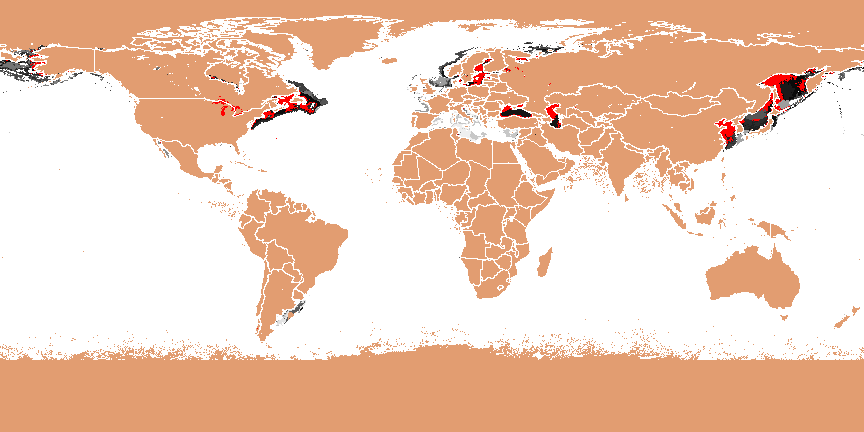
William W. Hargrove, Matt Fitzpatrick, Arthur Stewart, Don Catanzaro,
David Eskew, and Forrest M. Hoffman
 |
Aquatic invasive species are transported with normal ship traffic, often in ballast water. This study attempts to predict susceptibility by quantifying the degree of multivariate similarity of aquatic environments worldwide to selected locations within the Great Lakes, USA.
Our approach assumes that, sooner or later, transport of invasive aquatic organisms will occur to and from all points on the globe. Following such human-mediated transplantations, it is the degree of similarity of the new aquatic environment to the original environment that determines whether the invader will successfully establish a population in the new location.
Toward this end, we have produced multiple sets of aquatic ecoregions. Some sets included information on bathymetry, or water depth, while some did not. Calculation of the quantitative ecoregions is described in the parent pages referenced above.
Here we use these global quantitative aquatic ecoregions to calculate and map the degree of similarity between aquatic environments found within the Great Lakes and other aquatic environments throughout the rest of the world. In the first two of four sections, we show degree of similarity between all global aquatic habitats and the most similar quantitative aquatic ecoregion present within the Great Lakes. The first section shows similarities calculated on the basis of seven characteristics of surface water, including minimum, maximum, and mean temperature, chlorophyll content, turbidity, water leaving radiance, and bathymetry, or water depth. The second section maps similarities without considering bathymetry, on the basis of only the other six characteristics.
In the third section, we sequentially map global similarity to the seven single largest quantitative ecoregions occurring within the Great Lakes, in order by their size. Finally, we map the degree of similarity between aquatic environments at the ten busiest ports within the Great Lakes and aquatic environments worldwide.
363 of the 5000 global aquatic ecoregions occur within the Great Lakes system, whose eextent is shown in the map below. Statistical ecoregion numbers 1, 5, 16, 19, 31, 46, 48, 76, 81, 97, 109, 114, 128, 136, 170, 171, 172, 184, 194, 206, 214, 231, 235, 288, 290, 317, 325, 351, 364, 398, 403, 419, 452, 460, 467, 469, 483, 495, 496, 503, 531, 540, 617, 622, 624, 645, 650, 682, 688, 699, 731, 733, 751, 760, 767, 768, 773, 780, 794, 817, 824, 864, 880, 948, 985, 1025, 1031, 1034, 1045, 1054, 1065, 1072, 1084, 1091, 1127, 1166, 1174, 1183, 1194, 1214, 1220, 1233, 1238, 1249, 1261, 1266, 1271, 1301, 1304, 1345, 1354, 1365, 1371, 1408, 1425, 1432, 1444, 1446, 1449, 1458, 1473, 1474, 1478, 1495, 1516, 1544, 1562, 1576, 1589, 1590, 1631, 1640, 1650, 1651, 1665, 1680, 1681, 1721, 1727, 1743, 1760, 1771, 1791, 1802, 1825, 1830, 1836, 1845, 1848, 1867, 1889, 1895, 1904, 1907, 1920, 1938, 1947, 1964, 1986, 1996, 2022, 2025, 2026, 2040, 2058, 2099, 2105, 2138, 2154, 2177, 2208, 2261, 2299, 2301, 2337, 2349, 2352, 2378, 2383, 2389, 2391, 2392, 2401, 2421, 2424, 2434, 2443, 2457, 2470, 2479, 2496, 2530, 2571, 2665, 2679, 2689, 2696, 2702, 2738, 2742, 2750, 2753, 2758, 2771, 2774, 2797, 2804, 2805, 2806, 2810, 2814, 2821, 2833, 2853, 2892, 2893, 2896, 2900, 2910, 2931, 2940, 2945, 2977, 2983, 2999, 3003, 3028, 3032, 3033, 3059, 3065, 3066, 3068, 3070, 3097, 3104, 3128, 3142, 3152, 3180, 3187, 3200, 3223, 3255, 3259, 3260, 3262, 3275, 3283, 3284, 3290, 3312, 3313, 3321, 3326, 3331, 3333, 3337, 3374, 3393, 3395, 3437, 3442, 3445, 3453, 3473, 3477, 3493, 3531, 3542, 3555, 3563, 3566, 3574, 3589, 3594, 3605, 3620, 3632, 3637, 3652, 3664, 3675, 3691, 3697, 3710, 3734, 3735, 3785, 3821, 3822, 3826, 3830, 3831, 3857, 3876, 3889, 3894, 3913, 3921, 3937, 3939, 3945, 3949, 3958, 3971, 3986, 3991, 3995, 4045, 4047, 4062, 4063, 4103, 4108, 4116, 4125, 4126, 4147, 4155, 4161, 4171, 4177, 4191, 4201, 4229, 4251, 4256, 4263, 4271, 4301, 4304, 4315, 4343, 4354, 4361, 4379, 4380, 4382, 4399, 4402, 4432, 4443, 4446, 4451, 4456, 4458, 4463, 4471, 4478, 4510, 4566, 4630, 4696, 4713, 4721, 4725, 4730, 4752, 4755, 4758, 4768, 4790, 4791, 4802, 4804, 4810, 4811, 4820, 4831, 4840, 4854, 4869, 4890, 4907, 4910, 4914, 4916, 4920, 4921, 4928, 4967, and 4991 all have at least one raster cell within the Great Lakes area, and are shown colored red below.
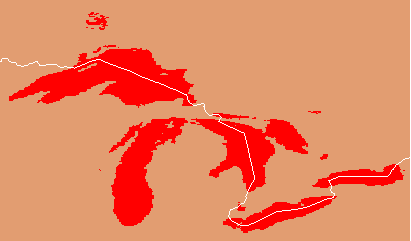 |
These 363 aquatic ecoregions comprise 100% of the area of the Great Lakes system, and served as the "training" set for the initial calculation of global similarity to the aquatic environments of the Great Lakes, or "Great Lakes-ness." The degree of multivariate similarity between each of the other 5000 aquatic ecoregions and the most-similar of these 363 ecoregions in the training set was calculated as the Euclidean distance separating the centroids of each aquatic ecoregion in an abstract data space. That separation distance was then mapped as a continuous gray scale, where black areas have very similar aquatic environments, and white areas have very different environments, in terms of the seven environmental variables considered in the analysis.
Click on any of the maps below to open a higher resolution version in another window.
 |
The 363 aquatic ecoregions in the training set also occurred outside the Great Lakes region, and are mapped in red. When dividing the globe into 5000 aquatic ecoregions, these areas represent *exactly* the same grouped combination of seven aquatic conditions that occur somewhere within the Great Lakes system.
Aquatic environments within the Ponto-Caspian region have long been suspected of having a high degree of environmental similarity with aquatic environments of the Great Lakes system. The map below provides an enlargement showing "Great Lakes-ness" within the Black, Caspian, and Mediterranean seas.
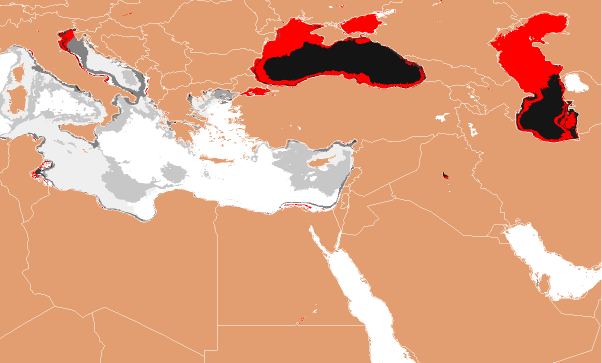 |
That the Black and Caspian Seas show high degrees of similarity with Great Lakes aquatic environments confirms the suspicions of experts that introductions of exotic species originating from these locations might pose an invasive threat to Great Lakes waters. However, many other locations worldwide, especially at similar latitudes, are revealed by this analysis to have equal or greater similarities to Great Lakes aquatic environments. Even some locations within homologous latitudes in the Southern Hemisphere may be suitable enough to exchange exotic species with the Great Lakes region. Red regions with exact environmental matches are often spatially surrounded by black and gray areas of high similarity, as one would expect from spatially autocorrelated water conditions.
Both oceanic and lacustrine environments are identified as having similarity to Great Lakes aquatic environments, since salinity characteristics were not included in the analysis. Some potential invasive species may be able to tolerate a wide range of salinity, however.
Three other areas of the world show similarities to Great Lakes aquatic environments of the same or greater degree than the Ponto-Caspian region. The northern Atlantic seaboard, Gulf of St. Lawrence, and waters surrounding Newfoundland comprise one region of high similarity. The southern edge of Hudson Bay also scores highly.
A second area of potential concern is in Scandanavian waters. Exact Great Lakes conditions are found in the Baltic and White Seas, with neighboring regions of high similarity in the North Sea and Barents Sea.
Finally, a large region consisting of the Yellow Sea, the East China Sea, the Sea of Japan, and the Sea of Okhotsk surrounding the Kamchatka penninsula shows a high degree of "Great Lakes-ness." This area extends eastward to include parts of the northern Bering Sea and Straits and part of the Gulf of Alaska.
The Gulf of California and the Sea of Cortez show moderate similarity, as do the waters off the west coast of Argentina and Uruguay in South America. Parts of the western, central, and eastern Mediterranean also score high in their degree of "Great Lakes-ness."
151 of the 3000 global aquatic ecoregions generated without bathymetry occur within the Great Lakes system, whose extent is shown in the map below. Statistical ecoregion numbers 15, 39, 42, 73, 104, 133, 160, 167, 248, 252, 266, 325, 365, 413, 456, 459, 465, 470, 486, 497, 500, 503, 508, 570, 573, 601, 725, 738, 773, 775, 781, 782, 784, 818, 845, 849, 860, 870, 897, 909, 935, 936, 937, 1008, 1024, 1026, 1077, 1127, 1138, 1171, 1239, 1260, 1263, 1294, 1303, 1304, 1337, 1341, 1403, 1477, 1479, 1481, 1562, 1583, 1585, 1593, 1596, 1599, 1626, 1628, 1644, 1651, 1676, 1706, 1719, 1754, 1759, 1771, 1787, 1801, 1828, 1834, 1856, 1865, 1887, 1902, 1924, 1926, 1937, 1945, 1970, 2006, 2007, 2044, 2069, 2099, 2105, 2119, 2144, 2167, 2192, 2195, 2219, 2238, 2265, 2274, 2279, 2287, 2289, 2290, 2293, 2294, 2324, 2342, 2360, 2365, 2405, 2418, 2426, 2431, 2436, 2438, 2447, 2457, 2484, 2489, 2550, 2551, 2565, 2571, 2586, 2592, 2593, 2624, 2636, 2670, 2687, 2706, 2728, 2737, 2748, 2788, 2810, 2812, 2836, 2842, 2850, 2866, 2880, 2950, and 2953 all had at least one raster cell within this map extent, and are shown colored red below. These aquatic ecoregions comprise the "training" set for the calculation of global similarity without bathymetry.
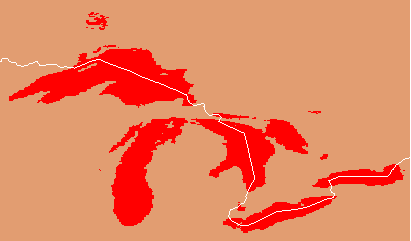 |
The world map below shows global "Great Lakes-ness" calculated without bathymetry. Click on any of the maps below to open a higher resolution version in another window.
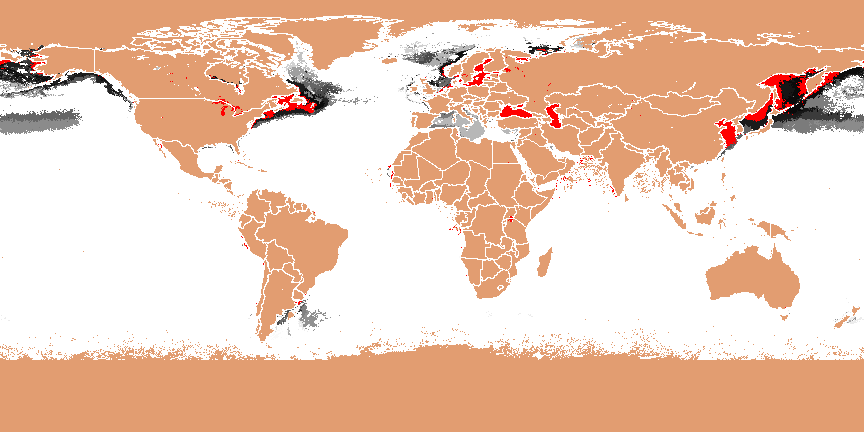 |
The map below provides an enlargement showing "Great Lakes-ness" within the Black, Caspian, and Mediterranean seas.
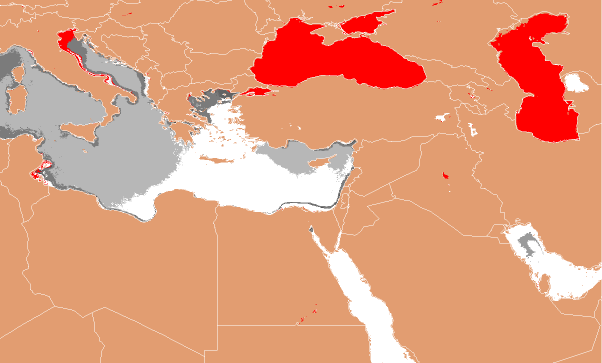 |
Division of the world's water environments into only 3000 aquatic ecoregions, and basing those ecoregions on one fewer criterion results in the identification of more areas as similar to Great Lakes aquatic environments. Larger areas are indicated in red and black on these maps. For example, the entire Black and Caspian seas are shown to share the same aquatic ecoregions as those found in the Great Lakes. Additionally, locations in the Gulf of California, off the coast of Angola in West Africa, Lake Victoria in East Africa, isolated spots throughout the Gulf of Aden and the north Arabian Sea, and the Laccadive Sea off the western tip of India are all identified as sharing the same aquatic ecoregions with the Great Lakes region. While Lake Victoria is unlikely to exchange shipping traffic with the Great Lakes, it represents a source of specimens bought and sold in the aquarium trade.
There is a stronger and more extensive latitudinal similarity signal from the Sea of Japan through the North Atlantic without bathymetry. More areas of similarity are shown in the Gulf of Alaska, and in the Norwegian Sea toward Iceland. Finally, more extensive areas of similarity are identified off the west coast of South America into the southern Atlantic Ocean.
Despite these differences, the general pattern of similar regions is echoed in both analyses. In addition to similarities in the Ponto-Caspian, the same three additional regions in Newfoundland, Scandanavia, and off Eastern China and Japan are identified as close aquatic homologs to the Great Lakes in terms of the characteristics considered here.
The seven largest aquatic ecoregions delineated without bathymetry occurring within the Great Lakes from the 3000-ecoregion set are 1937, 1828, 1593, 2950, 2105, 1077, and 1801. Area in number of map cells is shown here. A natural division in the sorted sizes occurs beyond this point, prompting the selection of this number of ecoregions for similarity mapping. These largest seven ecoregions comprise 69.5% of the total area of the Great Lakes system.
As before, the single ecoregion selected for training is shown in red, and the continuous degree of environmental similarity is mapped from black (similar) to white (different). Global environmental similarity to each of the seven largest ecoregions is mapped below.
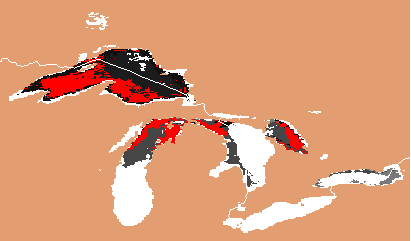 |
The world map below shows global similarity to Great Lakes aquatic ecoregion number 1937, calculated without bathymetry. Click on any of the maps below to open a higher resolution version in another window.
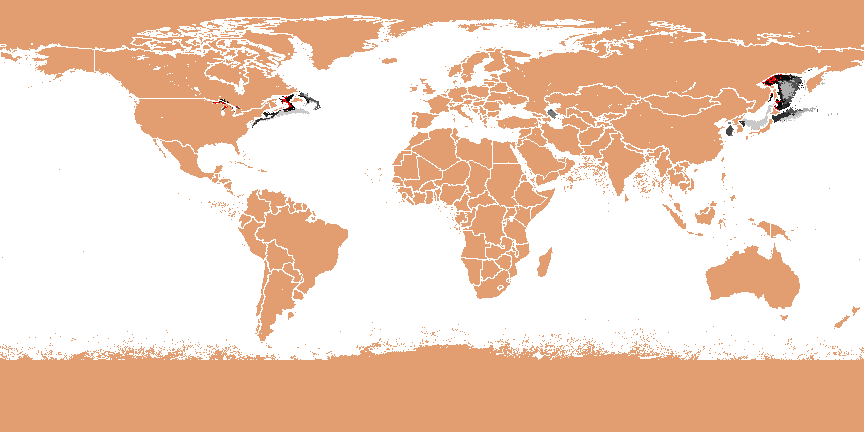 |
The map below provides an enlargement showing similarity to Great Lakes aquatic ecoregion number 1937 within the Black, Caspian, and Mediterranean seas.
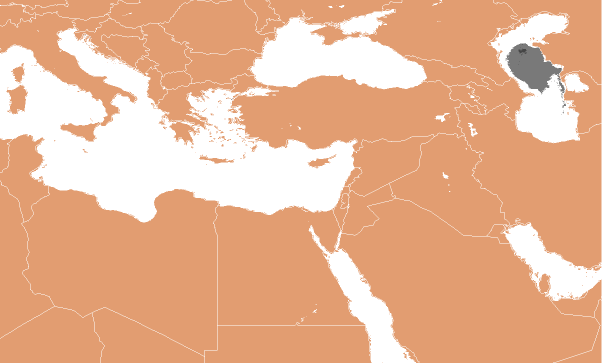 |
 |
The world map below shows global similarity to Great Lakes aquatic ecoregion number 1828, calculated without bathymetry. Click on any of the maps below to open a higher resolution version in another window.
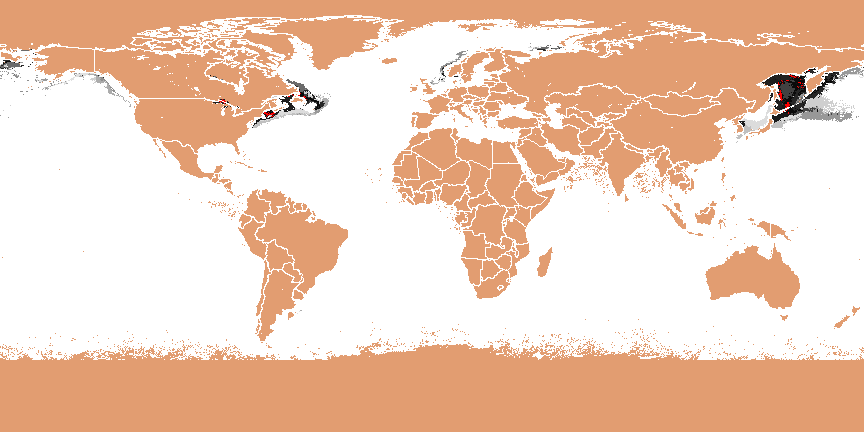 |
The map below provides an enlargement showing similarity to Great Lakes aquatic ecoregion number 1828 within the Black, Caspian, and Mediterranean seas.
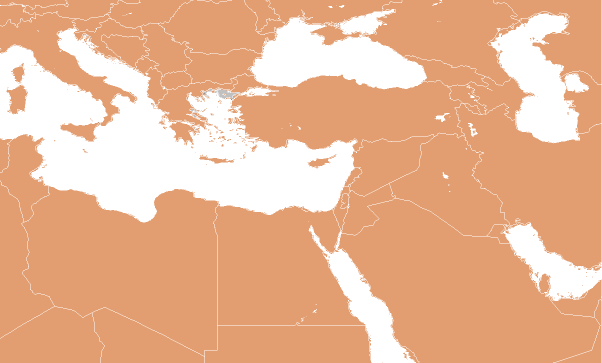 |
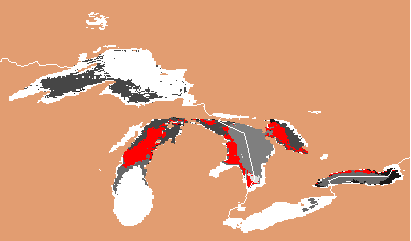 |
The world map below shows global similarity to Great Lakes aquatic ecoregion number 1593, calculated without bathymetry. Click on any of the maps below to open a higher resolution version in another window.
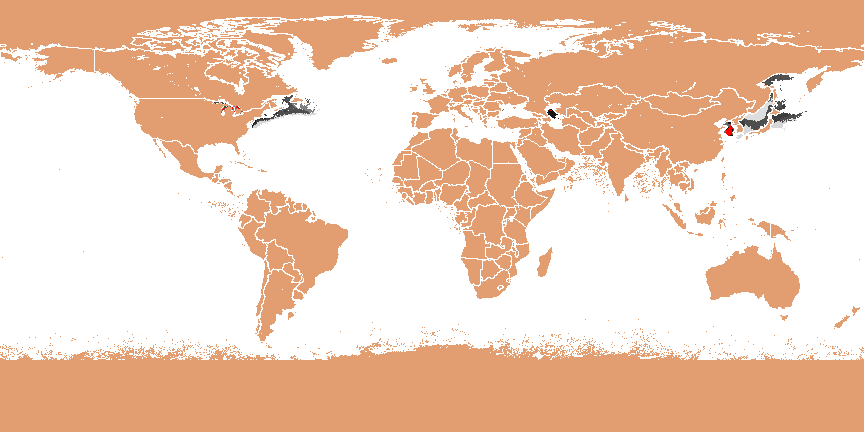 |
The map below provides an enlargement showing similarity to Great Lakes aquatic ecoregion number 1593 within the Black, Caspian, and Mediterranean seas.
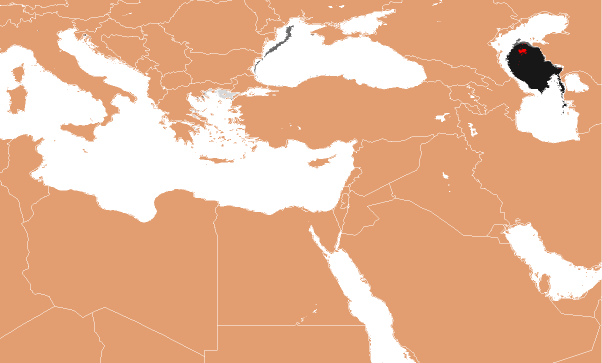 |
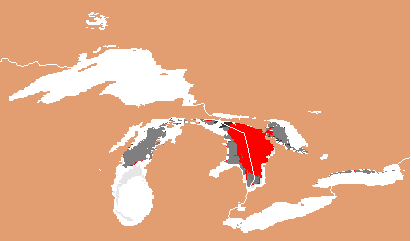 |
The world map below shows global similarity to Great Lakes aquatic ecoregion number 2950, calculated without bathymetry. Click on any of the maps below to open a higher resolution version in another window.
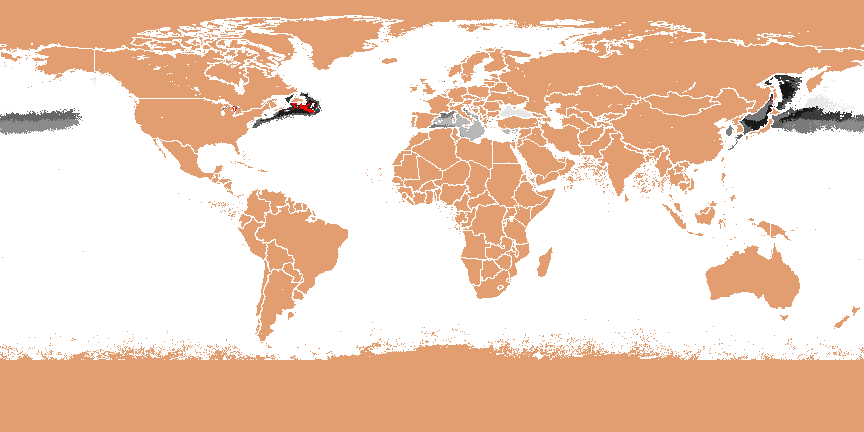 |
The map below provides an enlargement showing similarity to Great Lakes aquatic ecoregion number 2950 within the Black, Caspian, and Mediterranean seas.
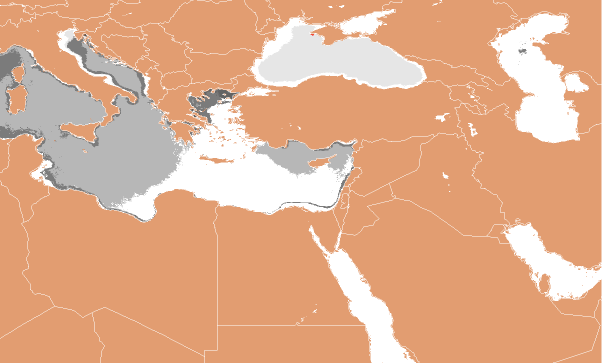 |
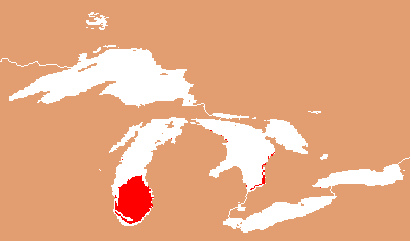 |
The world map below shows global similarity to Great Lakes aquatic ecoregion number 2105, calculated without bathymetry. Click on any of the maps below to open a higher resolution version in another window.
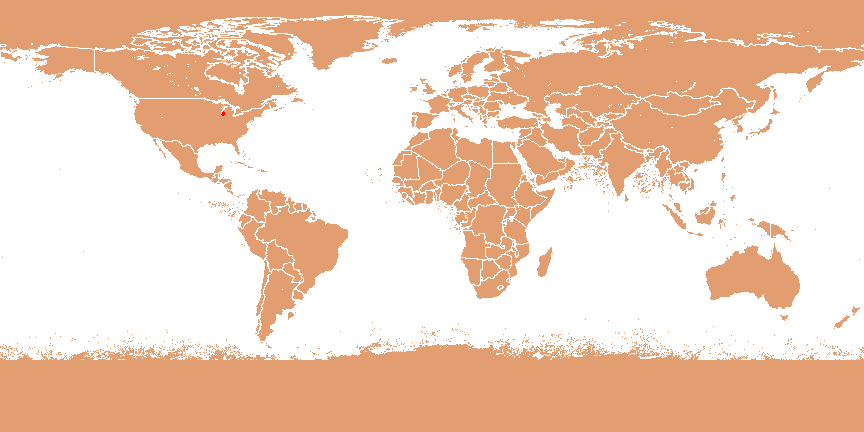 |
The map below provides an enlargement showing similarity to Great Lakes aquatic ecoregion number 2105 within the Black, Caspian, and Mediterranean seas.
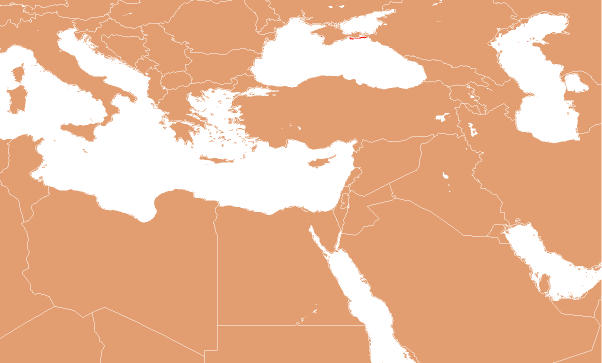 |
Apparently Great Lakes aquatic ecoregion number 2105 is highly unique among the world aquatic environments, even without consideration of its bathymetry.
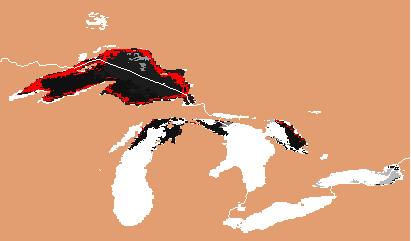 |
The world map below shows global similarity to Great Lakes aquatic ecoregion number 1077, calculated without bathymetry. Click on any of the maps below to open a higher resolution version in another window.
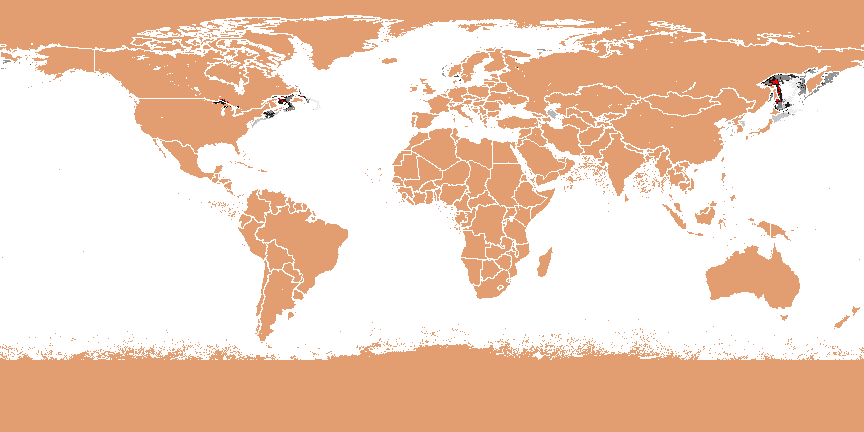 |
The map below provides an enlargement showing similarity to Great Lakes aquatic ecoregion number 1077 within the Black, Caspian, and Mediterranean seas.
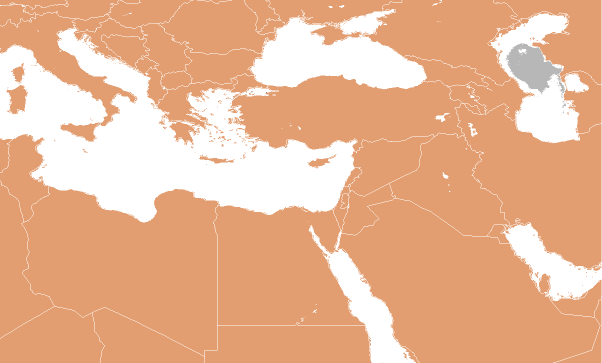 |
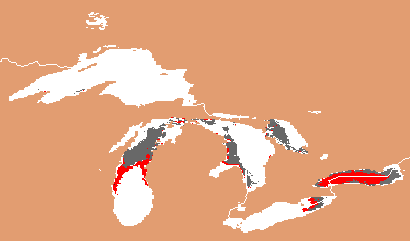 |
The world map below shows global similarity to Great Lakes aquatic ecoregion number 1801, calculated without bathymetry. Click on any of the maps below to open a higher resolution version in another window.
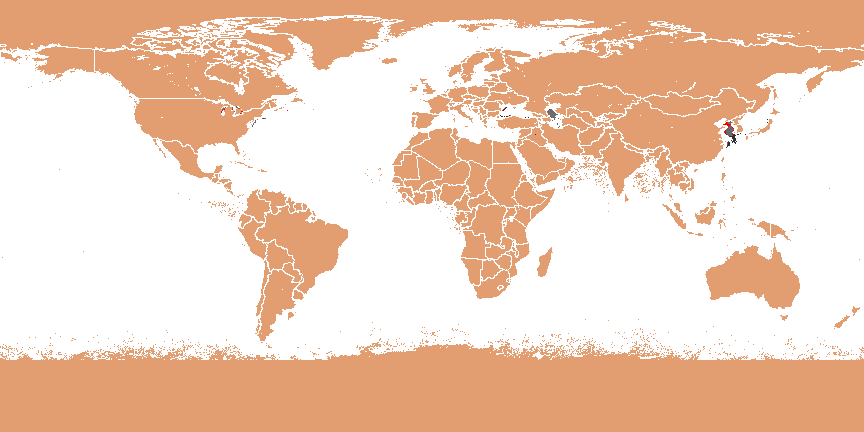 |
The map below provides an enlargement showing similarity to Great Lakes aquatic ecoregion number 1801 within the Black, Caspian, and Mediterranean seas.
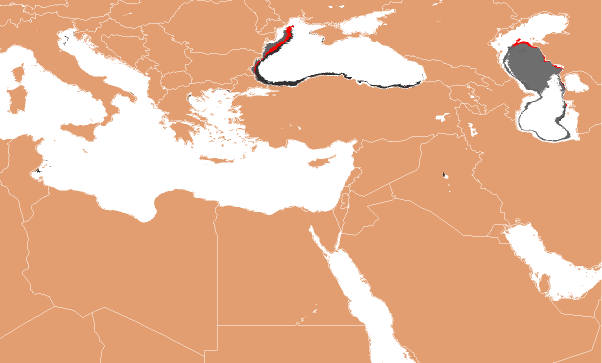 |
In the deeper waters found in the largest central aquatic ecoregions of the Great Lakes, depth is unlikely to be a critical factor limiting the establishment of invasive species. Conversely, in the relatively shallower waters of aquatic ecoregions surrounding destination ports of call, depth may be a more critical component of the newly invaded environment. Therefore, we used the aquatic ecoregions produced without bathymetry as the basis for similarity calculations involving the seven largest aquatic ecoregions of the Great Lakes, but we used the aquatic ecoregions produced with bathymetry for calculating the degree of similarity with destination ports.